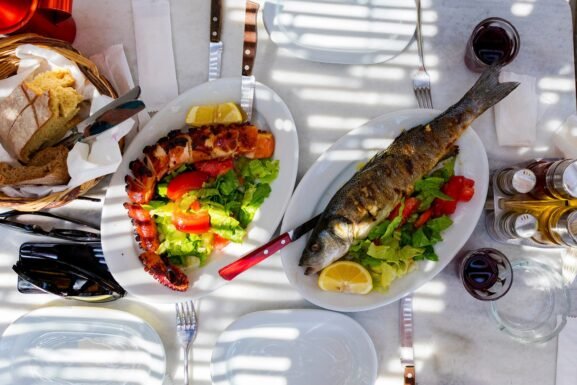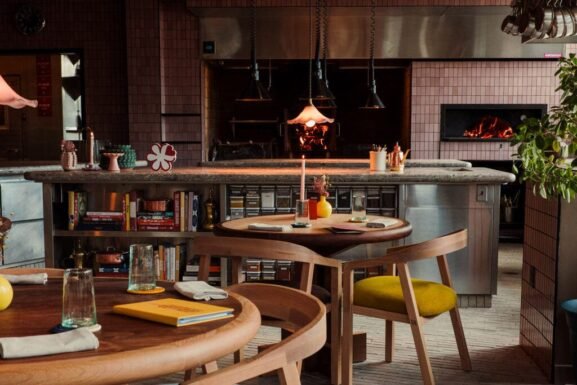Tin City is Paso’s Most Innovative Wine Hub
Paso Robles built its reputation on big, bold reds served in estate settings, where neat rows of vines lay underneath wide blue skies and gnarled oak trees as far as the eyes can see. So, how is Paso now home to a thriving urban wine scene, where the most exciting wines are everything other than red?
Welcome to Tin City, the collection of corrugated metal warehouses located down a dead-end road lined with cement trucks, pallet yards and tumbleweeds. Here, under the shade of tin roofs and steel tanks, some of Paso’s most influential winemakers are quietly crafting a revolution based on white, orange and rosé wines.
The shift reflects the ongoing diversification of the region’s winemaking culture, which is expanding beyond the Zinfandel, Bordeaux and Rhône grapes that have won it wide acclaim over the past few decades. But it reveals even more about how the American palate is maturing, with consumers increasingly open, and often seeking, wines that emphasize nuance over power.
You May Also Like: The Best Wineries (and More) to Visit in Paso Robles Right Now
“White wine was a token wine, if anyone was even bothering to do it,” explains Vailia Esh of Desperada Wines when she arrived in the region in the mid-2000s. “And they certainly weren’t doing any of consistent quality.”
In 2009, she launched her brand to produce half red and half white wines, appreciating the challenges and rewards of lighter wines. “You can throw Cab out of an airplane and by the time it hits the ground, it’s gonna be fine,” says Esh. “Whites take a defter hand, a little more attention to the winemaking process—you have to be a little more cautious.”
Her ratio remains half and half today, with Sauvignon Blanc accounting for about 90% of her white wine production. “I had a lot of respect for what Merry Edwards did in this industry, not only as a female winemaker but for bringing Sauvignon Blanc into the forefront,” says Esh, who was part of the second wave of producers to move into Tin City back in 2013. “So, why not try to highlight it and make it a focus?”
Dave McGee veered even deeper into the white wine lane when he started Monochrome Wines in 2016. “It seemed like everywhere, but particularly here, whites were not given the respect,” says McGee, who decided to only make whites. “I’m a bit of a contrarian. I wanted to make a lineup that had more character and complexity, but also exposed people beyond typical Sauvignon Blanc and Chardonnay.”
You May Also Like: Understanding the Differences Between Blending and Co-fermenting
He started by blending atypical cuvées like Gewürztraminer with Albariño and Chenin Blanc with Viognier. “That would never happen in Europe,” says McGee, who sees his wines as being uniquely Californian. “There’s no place where those grapes grow so close in distance.” He’s also unearthing little-known varieties, like Grenache Gris and Albilllo Mayor, to the delight of Tin City visitors.
“You’ve always got one or two people in a group that aren’t necessarily huge fans of big, bold Paso reds,” says McGee. “Historically, these people have been looked down upon. But they can come in here and their preferences are respected—they’re not treated as second-class citizens.”

Even some of the winemakers who helped Paso garner a reputation for its bold reds have embraced lighter styles of wine. After years of making heavy Cabs and Rhône-inspired reds for brands like Herman Story and McPrice Myers, French-born Xavier Arnaudin teamed up with Michigan-raised designer Philip Muzzy to create Union Sacré, where 95% of the production is white, rosé and orange wines.
“We are the joker in your deck if you want to try something surprising,” says Arnaudin, who follows the lead of Alsace in primarily producing Pinot Blanc, Pinot Gris, Sylvaner, Gewürztraminer and Riesling. “We believe in acidity: I want my wine tight, fresh and clean.”
This crisp, easy-drinking profile has made the tasting room especially popular in the warm summer months, when Paso temps often exceed 100°F. And it’s led to a widespread appeal for the brand, which produces a modest 16,000 cases per year, garnering fans across Europe and Asia. “Japanese people love our wines,” says Arnaudin. “The food is the perfect link.”
While Paso wines first caught attention by being loud and brash—and, to be clear, that style still dominates here—Union Sacré is betting that the future can be more about harmony. “Our wines are not made to impress, but just to be a good bottle to bring to a friend’s house,” says Arnaudin. “It’s just like the roast chicken you make for dinner. We don’t want wine to take over the conversation.”

This ethos of being paradoxical to the Paso norm started right at the beginning of Tin City. Andrew Jones was the original settler of the industrial hub back in 2012. His Field Recordings winery quickly became known for cool vibes and affordable prices, with a mix of blends and sparkling wines, particularly pét-nat, leading the way. Then came Skins, the brand’s foray into orange wine, which leaves white grapes on their skins for an extended period of time to extract more color, flavor and texture.
“It’s orange wine with training wheels,” he says of the label, which is mellower and more approachable than many of the pungent, tart and funky wines that fall under the orange umbrella. The brand has become a hit: Skins is now the literal poster child for orange wine—with billboards touting it along the busy 101 freeway—and it’s become Field Recordings’ most popular wine.
You May Also Like: Orange Wine is Trending for All the Right Reasons
Jones’ neighbors at Giornata Wines fly the orange flag high as well. Created in 2006 to produce mainly Italian varietal wines by Brian and Stephanie Terrizzi (who also own Tin City restaurant Etto Pasta Bar and nearby pasta factory Etto Pastificio), the winery started dabbling in skin-fermented styles of ramato, an Italian spin on rosé, more than a decade ago. That’s exploded to nine different orange wines, showcasing Vermentino, Falanghina, Fiano, Moscato Giallo and othebrirs with texture and nuance. “To me, it just gives you more tools,” says Brian of the skin-fermented lots. Stephanie adds, “they’re more spices on the racks.”
In spite of Tin City’s ever-growing diversity of styles and popularity as a tasting destination, red wines still rule the broader region—as they do across California. But even the region’s big-red wineries are treating whites more seriously now.
“I see the people who are focusing and giving it attention are doing a great job of it,” says Esh from Desperada. “I’ve never seen so many awesome white wines. It’s come a huge, long way.”

Field Recordings 2022 Skins White (Central Coast)
One of the most popular wines in the Field Recordings’ lineup, this skin-contact blend of 35% Chenin Blanc, 35% Pinot Gris, 12% Albariño, 12% Riesling, 4% Tocai Friuliano and 2% Verdelho really is fascinating. The pinkish-orange wine carries aromas of strawberry, red plum, rose water and melon rinds from the nose into a deeply textural palate, loaded in red apple and white-flower flavors. Believe the hype. Editor’s Choice. 93 Points — Matt Kettmann
$25
Wine.com

Union Sacre 2022 Edelzwicker White (Central Coast)
Orange sherbet, light berry, orange peel and grapefruit-pith aromas align on the nose of this eye-opening blend of 33% Pinot Blanc, 30% Pinot Gris, 20% Sylvaner, 10% Riesling, 5% Gewürztraminer and 3% Muscat Ottonel. It’s stunningly vibrant on the palate, where an energetic acidity cuts through the bold grapefruit and cantaloupe flavors. 92 Points — M. K.
$ Varies
K & L Wine Merchants

Giornata 2022 Moscato Giallo (Paso Robles)
$35
Giornata Wines
Published: February 6, 2024


